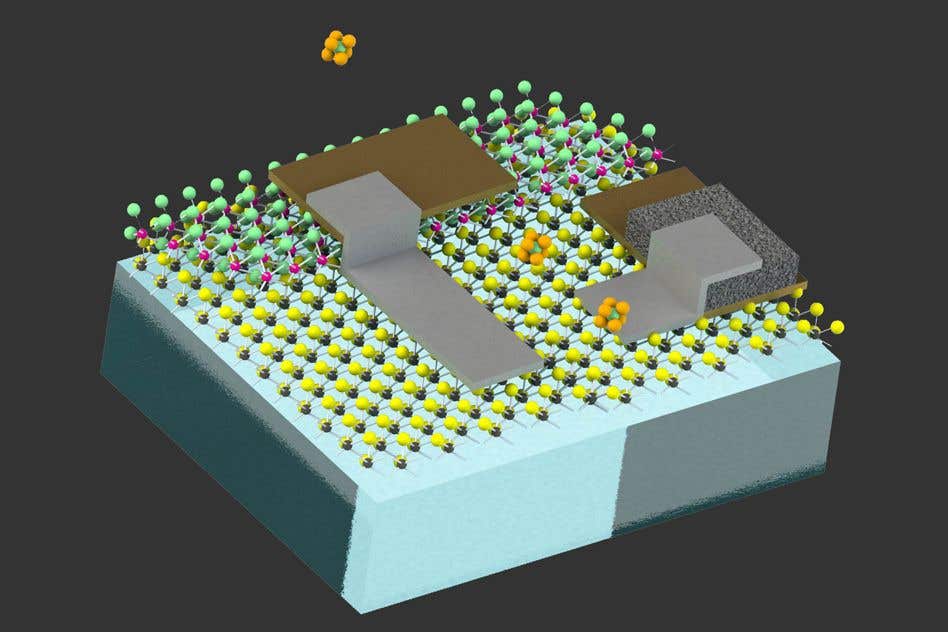Battery breakthrough revolutionizes the use of cell-sized medical robots
Engineers developed zinc-air batteries, smaller than a grain of sand, which could help miniscule robots sense and respond to their environment.

Cell-sized robot (CREDIT: MIT News)
A breakthrough from MIT engineers could revolutionize the use of cell-sized, autonomous robots for medical purposes, such as targeted drug delivery, and other practical applications like detecting leaks in gas pipelines.
At the heart of this innovation is a remarkably small battery, just 0.1 millimeters in length and 0.002 millimeters thick—about as thick as a human hair. This tiny powerhouse captures oxygen from the air to oxidize zinc, generating a current of up to 1 volt, which is sufficient to energize small circuits, sensors, or actuators.
According to Michael Strano, the Carbon P. Dubbs Professor of Chemical Engineering at MIT and the senior author of the study, “We think this is going to be very enabling for robotics. We’re building robotic functions onto the battery and starting to put these components together into devices.”
For years, Strano’s lab has focused on developing miniature robots that can sense and react to their surroundings. A significant hurdle in this field has been ensuring these robots have enough power to function autonomously. While solar power has been used to power such devices, this approach has its drawbacks—primarily the need for a constant external light source. This limitation means that these tiny robots are often more like "marionettes," reliant on external control.
To overcome this, integrating a battery into these devices is crucial for achieving true autonomy. “The marionette systems don’t really need a battery because they’re getting all the energy they need from outside,” Strano explains. “But if you want a small robot to be able to get into spaces that you couldn’t access otherwise, it needs to have a greater level of autonomy. A battery is essential for something that’s not going to be tethered to the outside world.”
Strano’s team opted to use a zinc-air battery, known for its high energy density and longer lifespan, commonly found in hearing aids. The battery they designed features a zinc electrode linked to a platinum electrode, all embedded within a polymer called SU-8, which is widely used in microelectronics.
When exposed to oxygen from the air, the zinc undergoes oxidation, releasing electrons that travel to the platinum electrode, creating an electric current.
Related Stories
The team demonstrated that this minuscule battery can provide enough power to operate an actuator, specifically a robotic arm capable of lifting and lowering. It can also power a memristor, a component that can remember events by altering its electrical resistance, and a clock circuit, allowing robotic devices to keep track of time.
Additionally, the battery can energize two types of sensors designed to detect chemicals in the environment by changing their electrical resistance. One sensor is made from atomically thin molybdenum disulfide, and the other from carbon nanotubes.
“We’re making the basic building blocks in order to build up functions at the cellular level,” Strano notes, highlighting the fundamental nature of their work.
Currently, the researchers used a wire to connect their battery to an external device. However, future developments aim to integrate the battery directly into the robots themselves. “This is going to form the core of a lot of our robotic efforts,” Strano states. “You can build a robot around an energy source, sort of like you can build an electric car around the battery.”
One of the most exciting prospects of this technology is the potential to create tiny robots that could be injected into the human body. These robots could seek out specific targets, such as diseased tissues, and release drugs like insulin exactly where needed.
For medical applications, the team envisions constructing these devices from biocompatible materials that would naturally degrade once their task is complete.
As they look ahead, the researchers are also exploring ways to increase the battery’s voltage, which could open the door to even more applications for these cell-sized robots. This innovation holds promise not only in medicine but across various industries where autonomous, microscale devices could play a transformative role.
Note: Materials provided above by The Brighter Side of News. Content may be edited for style and length.
Like these kind of feel good stories? Get The Brighter Side of News' newsletter.
Rebecca Shavit
Science & Technology Journalist | Innovation Storyteller
Based in Los Angeles, Rebecca Shavit is a dedicated science and technology journalist who writes for The Brighter Side of News, an online publication committed to highlighting positive and transformative stories from around the world. With a passion for uncovering groundbreaking discoveries and innovations, she brings to light the scientific advancements shaping a better future. Her reporting spans a wide range of topics, from cutting-edge medical breakthroughs and artificial intelligence to green technology and space exploration. With a keen ability to translate complex concepts into engaging and accessible stories, she makes science and innovation relatable to a broad audience.



